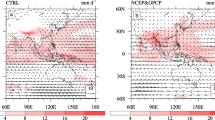Abstract
We estimate the impact of sulfate aerosols on cloudiness formation over the sea in the middle troposphere and the involvement of these particles in the formation of polar stratospheric clouds (PSCs) in the lower stratosphere. The first of these problems is solved using a combined model of moist convection and the formation of cloudiness and sulfate aerosols in the troposphere and lower stratosphere over the sea, incorporating natural emissions of sulfur-containing compounds. We have found that a significant source of condensation nuclei in the troposphere is the photochemical transformation of biogenic dimethyl sulfide (in addition to NaCl). The results of numerical experiments indicate that the absence of sulfate aerosols hinders the cloudiness formation over the sea in the middle and upper troposphere. The problem of sulfate aerosol involvement in the formation of supercooled ternary solutions (STSs) (PSC Type Ib) in the lower stratosphere is solved using a mathematical model of global transport of multicomponent gas pollutants and aerosols in the atmosphere. Using the combined model, numerical experiments were performed for the winter season in both hemispheres. Sulfate aerosols were found to really participate in the formation of STS particles. Without their participation, the formation of STS particles in the lower stratosphere would be hindered. We present the results of numerical calculations and discuss the distribution of concentrations of gaseous nitric and sulfuric acids, as well as mass concentrations of these components in STS particles.
Similar content being viewed by others

References
A. E. Aloyan, “Mathematical modeling of the interaction of gas species and aerosols in atmospheric dispersive systems,” Russ. J. Numer. Anal. Math. Modell. 15 (1–4), 211–224 (2000).
A. E. Aloyan, A. N. Yermakov, and V. O. Arutyunyan, “Formation of sulfate aerosols in the troposphere and lower stratosphere,” in Study of the Possibility of Climate Stabilization with New Technologies. Problems of Adaptation to Climate Change (Rosgidromet, Moscow, 2012), pp. 75–98 [in Russian].
A. E. Aloyan, A. N. Yermakov, and V. O. Arutyunyan, “Modeling the convective cloudiness and its impact on the atmospheric gaseous composition,” Izv., Atmos. Ocean. Phys. 46 (6), 713–726 (2010).
T. Gal-Chen and R. C. J. Somerville, “On the use of a coordinate transformation for the solution of the Navier–Stokes equations,” J. Comput. Phys. 17, 209–228 (1975).
Y. L. Kogan, “The simulation of a convective cloud in a 3-d model with explicit microphysics. Part 1: Model description and sensitivity experiments,” J. Atmos. Sci. 48 (9), 1160–1189 (1991).
G. I. Marchuk, Methods of Computational Mathematics (Nauka, Moscow, 1980) [in Russian].
A. E. Aloyan, Modeling the Dynamics and Kinetics of Gaseous Pollutants and Aerosols in the atmosphere (Nauka, Moscow, 2008) [in Russian].
A. E. Aloyan, “Mathematical modeling of convective cloudiness with phase transitions,” Russ. J. Numer. Anal. Math. Modell. 25 (5), 399–418 (2010).
A. E. Aloyan, A. N. Yermakov, and V. O. Arutyunyan, “Modeling the formation of polar stratospheric clouds with allowance for kinetic and heterogeneous processes,” Izv., Atmos. Ocean. Phys. 51 (3), 241–254 (2015).
http://wwwaimenvueaacuk/aim/aimphp.
K. Drdla and R. Müller, “Temperature thresholds for chlorine activation and ozone loss in the polar stratosphere,” Ann. Geophys. 30, 1055–1073 (2012).
J. C. Farman, B. G. Gardiner, and J. D. Shanklin, “Large losses of total ozone in Antarctica reveal seasonal ClOx/NOx interaction,” Nature 315, 207–210 (1985).
K. S. Carslaw, T. Peter, and S. L. Clegg, “Modeling the composition of liquid stratospheric aerosols,” Rev. Geophys. 35, 125–154 (1997).
O. Möhler and F. Arnold, “Gaseous sulfuric acid and sulfur dioxide measurements in the Arctic troposphere and lower stratosphere: Implications for hydroxyl radical abundances,” Geophys. Res. Lett. 19, 1763–1766 (1992).
S. R. Kawa, D. W. Fahey, K. K. Kelly, et al., “The Arctic polar stratospheric cloud aerosol: Aircraft measurements of reactive nitrogen, total water, and particles,” J. Geophys. Res. 97 (D8), 7925–7938 (1992).
Author information
Authors and Affiliations
Corresponding author
Additional information
Original Russian Text © A.E. Aloyan, A.N. Yermakov, V.O. Arutyunyan, 2016, published in Izvestiya Rossiiskoi Akademii Nauk, Fizika Atmosfery i Okeana, 2016, Vol. 52, No. 4, pp. 402–415.
Rights and permissions
About this article
Cite this article
Aloyan, A.E., Yermakov, A.N. & Arutyunyan, V.O. The role of sulfate aerosol in the formation of cloudiness over the sea. Izv. Atmos. Ocean. Phys. 52, 353–364 (2016). https://doi.org/10.1134/S0001433816040022
Received:
Published:
Issue Date:
DOI: https://doi.org/10.1134/S0001433816040022


